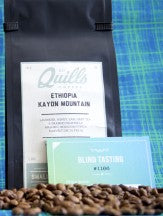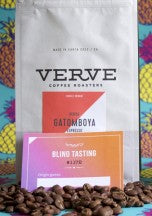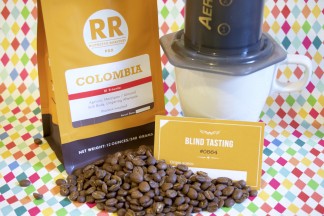At Angels' Cup, we ship blind coffee tasting flights to our subscribers to help them develop a sharper sense of taste. People sometimes wonder what flavor notes they should look out for in each coffee, so we've compiled
a short list explaining what flavors can most commonly be found in coffees from various origins. One quick caveat before we begin: no matter how hard you try, you probably won't find flavors in your coffee if you make either of the following two mistakes. 1) You add milk or sugar to your coffee. Not trying to be a coffee snob,
I encourage you to drink coffee however you like. But if you were trying to develop taste in wine, you probably wouldn't buy an exceptional bottle of Bordeaux and proceed to add orange juice and fruit to it. It's just not conducive to learning. 2) Your coffee is roasted too dark. Again, this is a matter of taste, you might not like light roasted coffee. If you like dark roast coffee, that's cool, stick with it. Lighter roasts tend to be sour, darker roasts tend to be bitter, and in-between is an oasis of sweetness and balance. But lighter roasts are more complex, and you may have to sacrifice sweetness and endure sour to get the most out of your coffee. But sour can be nice. Most fruit is sour, as are lollipops and fruit rollups. We promise you'll never have to endure more sourness drinking good coffee than your average sugar crazed 6 year old endures eating a tootsie pop. ?? The list below is arranged roughly in order of how obvious and striking the flavors are. If you're new, I recommend starting at the top, finding a coffee to try from each region, and working your way down. Oooorrrrr, try subscribing to Angels' Cup! You'll get an amazing variety of
coffees selected specifically to help you learn how different regions taste, and you'll avoid all the stinkers.
(click all pictures to enlarge)
Ethiopia (naturally processed)
For many, naturally processed Ethiopians (also called "dry-processed") are a gateway drug into specialty coffee. Just grinding this coffee fills the room with
blatant blueberry aroma, and that flavor comes through in the cup as well. The blueberry flavor in naturally processed Ethiopian coffees is the most unmistakable flavor characteristic in the world of coffee, you cannot miss it. In addition to blueberry, look for strawberry, artificial grape flavor (like a purple ice pop), muffin, and cream cheese. Another thing that sets natural Ethiopians apart is the creamy texture and the fact that this coffee packs tremendous fruit flavor without overwhelming acidity. People who are into coffee generally think of acidity as a good thing, average coffee drinkers... not so much. Natural Ethiopians are a win for everyone.
Ethiopia (washed process)

That's right, Ethiopia has the first AND SECOND most identifiable coffee flavor profile of all the coffees on Earth. ?? Surprisingly, washed Ethiopian coffees taste completely different from naturally processed coffees, even from the same farm. They have three dominant flavors.
Tea, lemon citrus, and florals, with every coffee presenting these flavors in different proportions. The dry aroma is striking, and after smelling it once or twice you should be able to recognize it 85% of the time (assuming it's not too dark). Some of the best washed Ethiopians also present secondary flavors of peach, bergamot, Froot Loop lime, and honeysuckle. This coffee is very light, and some people dismiss it at first saying "I didn't come here to drink tea". To which I say "good, more for me". If you don't like your first one, try a few. It will grow on you.

Kenya
Right next door to Ethiopia, Kenya has an exceptionally distinct flavor profile all its own. Almost always, Kenyan coffee has a syrupy thick mouth coating quality with dominant flavors of tomato stew and raisin (or other dried fruit). Some of the best Kenyan coffees will also offer grapefruit and bubblegum. This coffee is divisive though, as the acidity/sourness is very prominent, especially in the higher quality offerings. Chocolate is also not uncommon, which combines with the raisin for a really nice Raisinette flavor.
Burundi, Rwanda & the rest of Africa
Generally speaking, coffee from the rest of Africa tastes like it's from Kenya, but not as distinct. While there are some standouts which really wow us with interesting flavors like ginger and winter spice, it's a more challenging region to buy coffee from.

Panama Geisha
There's one variety of coffee grown in Panama called Geisha (or Gesha). It's generally the most expensive coffee in the world, and particularly favored by coffee professionals competing in barista competitions. Production is evenly mixed between natural and washed, but the dominant flavors are generally floral, with
honeysuckle and bergamot standing out the most. Other coffee from Panama is not like Geisha, and Geisha from other countries is not like the product of Panama. But because it's so expensive, you're probably best off waiting for a special occasion to try this one. It's too expensive to have every morning.

Indonesia (ex Papua New Guinea)
Indonesian coffee is known for its heavy (almost sandy) body, and an earthy, woody flavor. It is very distinct, but not a go-to choice for most coffee people because acidity and complexity can be lacking. However, we have had some recently that present really nice tropical fruit flavors, cinnamon, and cola. So it's worth trying given the opportunity!
Yemen
All coffee from Yemen (that's we've seen) is naturally processed, and so it has a certain wildness to it. The region has a bad habit of producing coffee that tastes like a barnyard. But when they get lucky and produce good coffee, it's exceptional. Dominant flavors are probably
sandalwood, nutmeg and cinnamon spice, and berry.

Colombia
Colombia is our favorite growing region in the Americas. There isn't necessarily one flavor profile that really stand out, but the best coffees from colombia have
cola, cherry, orange, vanilla, chocolate, florals, and maybe even apple flavors. It also can have excellent sweetness and balance. If you're getting a ton of complexity but don't think the coffee is from Africa, chance are Colombia is a good guess.

Nicaragua
Coffees from Nicaragua stand out for almost always having a very pleasant
tobacco flavor. I'm assuming that's because tobacco is grown nearby.
Brazil & Mexico
In the Americas, the further away from Colombia you move, the more complexity is lost. What's left behind is usually
chocolate and nuts (mostly peanut). Brazil is as far south as coffee production goes, and Mexico is as far north. Both regions produce somewhat similar cups. The best examples will have decent sweetness and acidity, with a chocolate and peanut combo reminiscent of peanut butter cups. They can be really nice. But they can also taste like cardboard or newspaper. Many are used as fillers for dark roasted espresso blends.

Guatemala, El Salvador, Honduras, & Costa Rica
Coffee from these regions are very difficult to tell apart. I sometimes get miso or seaweed as a flavor, which is a giveaway, but usually they just taste like they're somewhere between Colombia and Mexico. It's all a blur.
All other regions
The regions listed above probably make up 99% of what you'll see in the specialty coffee world. Occasionally we'll get to try something special from a place like Myanmar, Thailand, Hawaii, etc., but it would be hard to try 50 different coffees from those regions to really get a sense for how they taste.








